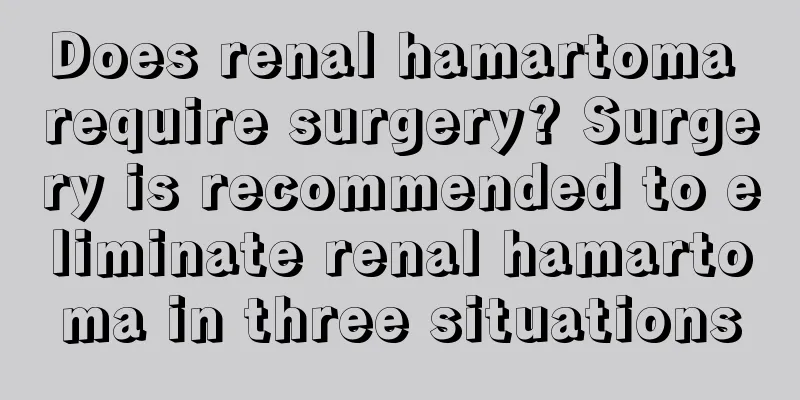Does renal hamartoma require surgery? Surgery is recommended to eliminate renal hamartoma in three situations

|
Renal hamartoma is a benign tumor, so when the tumor is small and does not affect daily life, conservative treatment can be performed, and regular check-ups at the hospital are required. Pay more attention to daily life, eat a reasonable diet, maintain a regular work and rest schedule, and strengthen exercise. However, when the renal hamartoma is large, compresses and invades surrounding organs, or ruptures and bleeds, surgery is recommended as soon as possible. Since renal hamartoma is a benign lesion, most cases have a good prognosis after surgical resection. However, some cases do not require surgery because the tumor is small and does not affect normal life. Clinically, it is necessary to choose an appropriate treatment plan based on the condition, the size of the tumor, whether the tumor is found to be invasive or bleeding, etc. So does renal hamartoma require surgery? In which three situations is surgery recommended to eliminate renal hamartoma? Treatment principles Tumors <4 cm are not treated; giant renal hamartomas may be treated with nephrectomy. Treatment strategy Tumors <4 cm may not require treatment, but close follow-up is required. Tumors <5 cm may require enucleation; giant renal hamartomas may require nephrectomy. Surgery 1. Nephron-sparing surgery Tumors <5 cm can be enucleated, especially those at the edge of the kidney. For cases with smaller tumors, laparoscopic nephron-sparing partial nephrectomy (LpN) is an effective surgical treatment. 2. Nephrectomy Giant renal hamartomas can be treated with partial or complete nephrectomy. If the disease is bilateral, more consideration should be given to the preservation of renal function. In a few cases, there may be local and lymph node invasion, or even tumor thrombus invasion of large veins, showing malignant behavior, and radical nephrectomy should be performed. Other treatments 1. Embolism Arterial embolization should first be considered in cases of bleeding. According to experience, the volume of the tumor does not decrease after embolization, but the bleeding can be stopped. Superselective renal artery branch embolization is often used to protect some renal function. 2. Kidney transplantation or hemodialysis It is only suitable for patients who must undergo bilateral nephrectomy due to bilateral lesions leading to renal failure or tumor rupture and bleeding. Prognosis Unilateral renal hamartoma is a benign lesion with a good prognosis. Bilateral, multiple lesions and renal insufficiency still affect the quality of life despite conservative treatment. In a few cases where multiple organs are invaded, such as lymph nodes, brain, heart, or even blood vessels, the prognosis depends on the degree and range of the invaded organs. |
<<: Early symptoms of throat cancer in women
>>: Will renal hamartoma continue to grow?
Recommend
How to care for lung cancer patients? 5 key nursing measures for lung cancer
Lung cancer is not very rare in our daily life, b...
What to do if the sweat pores on the face are clogged with small black spots
Hair clogging is a very common phenomenon. As we ...
Conscious while sleeping but unable to move
Sometimes we sleep very deeply and know that we a...
What are the pictures of prostate cancer symptoms
What are the symptoms of prostate cancer? Prostat...
Effect of high-efficiency scale remover
Scale is easily hidden in many places in life, bu...
Does endocrine therapy for prostate cancer work?
Does endocrine therapy work for prostate cancer? ...
Can I drink centipede wine?
Many people use centipedes to make wine, but is c...
What kind of chemotherapy drug is best for breast cancer metastasis to the lungs
What chemotherapy drugs are best for breast cance...
What kinds of cookies are there?
In daily life, biscuits are liked by many people ...
What is the reason for feeling sleepy after eating?
People feel sleepy after eating, especially in sp...
Is it okay not to wear underwear for a long time during breastfeeding?
In the minds of many women, the time to wear unde...
The main functions of probiotics
Probiotics are a type of fungus, but they are com...
How long can you live if cervical cancer worsens in the late stage
In our lives, we often ignore our own health prob...
What happens if the water for foot bath is too hot
Many people like to soak their feet before going ...
What are the dangers of eating ice cream
Ice cream is a great summer refreshment because i...









